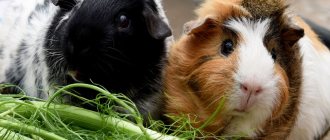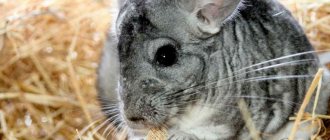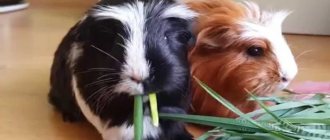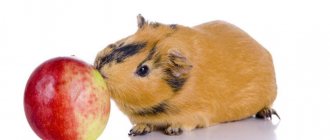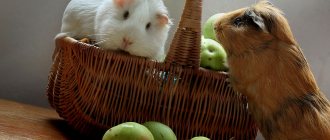One of the most important components of a guinea pig's diet is green food. This food is inexpensive, contains all the necessary nutrients, and is easily eaten and absorbed by animals. Is it possible for guinea pigs to have fresh grass, and what kind of grass can be fed to these pets we will look at in our article.
All sown cereals and legumes, as well as meadow, steppe and forest grasses can be used as green fodder. The most useful are mixtures of legumes and cereal-legume herbs, containing large amounts of protein, vitamins and minerals. This can be Sudan grass, peas, clover, lupine, alfalfa, sweet clover, vetch, sainfoin, corn, winter rye, etc.
As green food, pigs can be given wild herbs - nettle, plantain, wheatgrass, yarrow, dandelion, rapeseed, sage and others. You can also offer these rodents tops of melons or garden crops, leaves, shoots and twigs from some bushes and trees.
Now let's take a closer look at each type of green food and determine what is beneficial for guinea pigs and what is not.
Dandelion
The most common question is: can guinea pigs eat dandelions? Dandelion is one of the most common plants, growing in a variety of places - in vegetable gardens, orchards, parks, fields, lawns, and also near roads.
You can give your guinea pig all parts of the plant - leaves, flowers, root and stem. But only the leaves and roots of this plant have nutritional value. Dandelion leaves contain carotene, choline, vitamin C, potassium, calcium, and iron. Inulin, sucrose, organic acids, various vitamins and microelements accumulate in the roots.
Dandelion leaves can be fed from early spring until late autumn. Substances contained in the leaves and roots of this plant stimulate appetite, enhance digestion, and cleanse the blood. But this plant cannot be given in large quantities. The amount of dandelion fed should not exceed 30% of the total daily intake of all green food.
Poisonous plants
When going to collect herbs for your beloved pet, you need to remember that there are a number of poisonous plants that not only cause poisoning, but also lead to death.
Plants that are poisonous and dangerous to guinea pigs include:
- Fighter,
- Arum,
- white acacia,
- Common aloe
- Common and lemon geraniums,
- All types of ferns,
- All types of lilies,
- Sorrel,
- Nightshade,
- Henbane,
- Lilies of the valley,
- All varieties of narcissus,
- Hyacinths,
- Celandine.
The following are considered dangerous for animals:
- Bay leaf,
- Gorse,
- All types of wisteria,
- Yew,
- All varieties of ivy,
- Deren,
- Common broom,
- Dogwood and all varieties of honeysuckle.
Nightshade is a very poisonous plant and leads to death.
Of the tree species it is strictly forbidden to feed:
- Thuja and oleander sprigs,
- Biryuchina,
- Juniper shoots and roots,
- Berries, leaves and twigs of elderberry,
- mistletoe,
- Leaves, shoots and twigs of hellebore and belladonna.
Plantain
Can guinea pigs eat plantain? Plantain leaves contain potassium, carotene, citric acid, vitamin C, tannins, and alkaloids. Plantain is an anti-inflammatory, sedative, helps with digestive system disorders, scabies and allergies.
Consuming plantain reduces blood sugar levels. This plant has been used to treat diabetes since the times of Ancient Greece and Rome. Plantain is especially indicated for complicated forms of diabetes. In a limited form, this plant can be given to guinea pigs.
Green feed
Many breeders, especially beginners, do not know what type of succulent green food they can offer their pets. After all, some herbs are dangerous not only to the life, but also to the health of domestic rodents.
We invite you to familiarize yourself with a fairly extensive list of permitted herbs:
- dandelion roots and leaves;
- sow thistle;
- shepherd's purse;
- coriander;
- peas;
- sprigs of dill, parsley;
- lettuce leaves;
- cilantro;
- celery;
- nettle;
- leaves and stems of beans, peas;
- leaves of plantain, yarrow;
- young corn shoots.
Ryegrass, vetch, sweet clover, oats and winter rye complete the list of permitted products.
Chamomile
The inflorescences of chamomile or chamomile contain essential oil, azulene, choline, organic acids, carotene, vitamins, etc. Chamomile is used as an anti-inflammatory, antispasmodic and carminative. The most valuable is the essential oil of this plant, which has a disinfectant, analgesic, and diaphoretic effect.
It is recommended to give chamomile for bloating in the form of tea or herbs; for diarrhea, give a strong decoction - 0.5 tbsp. for 1 tbsp. water three times a day. You should not collect chamomile near roads and railway lines, near landfills, animal farms and oil storage facilities - chamomile absorbs toxic substances from groundwater and the environment. It is better to collect in a forest or field, away from roads.
How to process correctly
It is important to know not only what grass can be given to pet rodents, but also how to process it correctly. Grass collected in the ecozone does not need to be washed. It is worth remembering that water only washes away the remaining dust, but does not eliminate the toxic substances that the greenery has absorbed.
It is strictly forbidden to process green food with boiling water. Heat-treated herbs should not be fed to these animals. Some breeders believe that in this way they can destroy parasite eggs, but this is deeply misleading. It is impossible to destroy them by heat treatment.
In addition, heat treatment of greens makes it absolutely useless for the animal’s body, since under such influence all useful substances are destroyed.
It is not recommended to give a lot of fresh greens after wintering. An animal that is not accustomed to succulent food may get sick. Most often this provokes gastrointestinal upset, diarrhea and vomiting.
Sorrel
Can guinea pigs eat sorrel? Sorrel contains proteins, fiber, carbohydrates, oxalic acid, folic acid, thiamine, ascorbic acid and other vitamins. This plant is a rich source of potassium and also contains calcium, sodium, phosphorus, chlorine, copper, zinc and other substances.
Sorrel can be given to guinea pigs, only in small quantities and not every day. It is not recommended to give horse sorrel to pigs.
Sorrel, like dandelion, when fed in large quantities, can cause bloating or upset the pet's digestive system. Due to the presence of oxalic acid, when consuming large amounts of this plant for a long time, a violation of mineral metabolism in the body and kidney stones may occur. Therefore, sorrel grass can be given to guinea pigs in limited quantities.
Benefits of herbs
To understand why grass and greenery are so important, you need to know that guinea pigs are herbivores. Their digestive system is adapted to digest coarse plant fibers. And so that the body does not malfunction, the diet should always contain fiber, which is found in grass and leaves.
Fruits and vegetables cannot replace hay, lush grass and leaves. Even if they exceed the nutrient content many times over, they will not provide the required amount of fiber.
Corn
Can guinea pigs eat corn? Young green corn, containing a large amount of sugar, is very nutritious and economically beneficial as green fodder. This food is great for guinea pigs. Young corn should be used as food for guinea pigs from the beginning of eruption until the panicle is thrown out. Adult rodents are given up to 70%, and young rodents - up to 40% of the daily requirement of green food. It is best to use a mixture of corn with alfalfa, clover and other grasses.
Prohibited:
1. Collect grass near roads, in places where animals are walked and grazed, near landfills, industries with harmful emissions, as well as grass that has been treated with pesticides or fertilizers.
2. Collect grass in places where there is a high number of ticks. These insects can hide in the grass and then very easily attach themselves to your pet.
Grains, nuts and seeds
Most guinea pig owners purchase ready-made grain mixtures. As a rule, animals calmly eat purchased food in combination with succulent foods and feel great for some time. However, if the owner of the rodent did not pay attention to the nutritional pattern of his ward, the animal may soon begin to have health problems.
Some pigs choose from a grain mixture and eat only sweet dried fruits and seeds, which contain a lot of fats and carbohydrates. This often leads to obesity, liver disease, and heart failure. The most common symptoms of animal malnutrition are:
- diarrhea;
- bloating;
- the appearance of dental problems;
- constipation;
- shifting the nutritional balance from succulent feed to grain.
If at least 2 of the listed signs are observed, it is necessary to urgently change the grain mixture. You should choose a composition with a lower carbohydrate content, which has a predominant amount of wild grains.
You can prepare the grain mixture yourself. But it is important to remember that cereals should not be boiled or scalded with boiling water. They are mixed with grains and given to pets in small quantities (30% of the diet).
Table 5. Permitted and prohibited components of the grain mixture.
| Can | It is forbidden |
| Barley grains, lentils, rolled oats, oats (unpeeled), pearl barley. | Millet, corn grits, rice grains, buckwheat. |
When choosing combinations of grain mixtures, it is necessary to take into account the age of the animal, the degree of its mobility, the time of year, and the weight of the rodent. This will help avoid problems with obesity and the development of gastrointestinal pathologies.
Results
In moderate doses, fresh grass can be added to the daily diet of guinea pigs. But before you offer your pet fresh grass, be sure to check out what properties it has and whether your pig can eat this particular type of green food.
Did you like the article? Share with friends: [supsystic-social-sharing id=”1"]
- Related Posts
- How to determine the sex of a guinea pig
- Guinea pig breeds
- What fruits and berries can guinea pigs eat?
« Previous entry
Feeding rules
To provide your pet with a balanced diet, you need to familiarize yourself with the rules and regulations for feeding guinea pigs.
- It is advisable to feed your pet at the same time. This way he will develop a routine.
- Feed should be given little by little and fresh each time. All leftovers from the previous meal should be thrown away. It is permissible to leave only hay in the cage.
- The diet should not contain limp greens, vegetables and fruits.
- Hay, grass and greens are the basis of nutrition; guinea pigs should always have them.
- Greens, grass, vegetables and fruits should be thoroughly washed. There is no need to peel fruits and vegetables.
- Water for guinea pigs should always be clean and should be changed once a day.
- In order for guinea pigs to grind their teeth, they need to be given tree branches: willow, ash, alder, apple, pear, linden, birch.
Foods harmful to guinea pigs
The following is a list of foods that can cause serious harm to a rodent's body:
- white and black bread, pasta;
- meat and dairy products;
- potato;
- mushrooms;
- baked goods, sweets;
- cereals, dry legumes;
- fruit and berry seeds;
- radish, radish;
- sorrel, rhubarb;
- juice, tea, jelly and other drinks other than water;
- leaves of indoor plants that are poisonous to rodents;
- canned food, spices, cheese and other delicacies;
- waste from the human table.
Guinea pigs love to chew on young tree branches. You should not give your pet oak, willow, pine, spruce, rowan, hornbeam, or elm branches. But you can safely put cherry, hazel, plum, apple, and pear branches in the feeder.
Twigs
From: Svinni - April 12, 2007 0:17 Good evening! I read that pigs should be given twigs to chew on. And what branches can they use (which trees or bushes) Thanks in advance
From: Mystery - April 12, 2007 3:14 am
From: Lanka.zp - April 12, 2007 3:57 am
There are a lot of topics on the forum about branches, but what to do with leaves? I read that apple, currant, raspberry, etc. branches are given with foliage. But what about willow, birch, I don’t mean fruit trees? Today I cut a bunch of branches, I’m sitting, thinking whether to pick off the leaves or leave them - this is our first spring, we have no experience in such things.
From: Galina - April 12, 2007 4:54 am
You can: birch, ash, maple, apple tree (dry the branches), alder, pear, willow (all types), rowan, linden. They can be given to the pig “for free use.”
Avoid: tree branches that have seeds in their fruit, i.e. apricot, peach, cherry, plum, etc. (because if they have not been dried for at least 6 months, they may contain cyanogen glucosides, which cause intoxication); branches of coniferous trees; citrus branches like orange, lemon, tangerine, etc. (contain limonin).
From: Lanka.zp - April 13, 2007 2:27 am
From: Galina - April 13, 2007 5:45 am
For free use - this means that the twigs (with or without leaves) can always be at the disposal of the pigs, they do not need to be limited. Here’s another example for you, a statement from the forum: My pigs get plenty of hard feed and their bite is fine. In the summer, I stocked up on apple branches with leaves (one of my favorite treats) as an additional diet; in addition to the leaves, she also eats branches, nibbles them off and eats them, chewing them thoroughly.
From: Svinni - April 13, 2007 2:45 pm
Can pigs have cherry branches and leaves? And I didn’t quite understand something, can I have imiren or not?
From: Galina - April 14, 2007 0:49
From: L_enok - April 14, 2007 2:50
And I gave my pigs and the little pig before them apple tree branches with leaves and birch. They tore down the birch tree with buds and whole twigs, and from the apple tree there was bark and young leaves at the entrance))) It seems to me that the animals themselves will not eat something harmful to them, although of course, the risk in this case is not justified and it is better not to try. Give only what is absolutely possible.
From: Venus - April 14, 2007 2:29 pm
Do any branches need to be dried for six months?
From: Galina - April 14, 2007 5:53 pm
From: Sana - April 14, 2007 6:53 pm
I only give birch and willow twigs (the only ones I can pick when we go to the pond, nothing else “edible” grows there). They go out with a bang! Just be sure to wash and dry!
From: CherTenoK - April 14, 2007 7:42 pm
Excuse me, but for example, dry apple tree branches with the leaves? Or can you tear off the leaves and give them fresh and dry the branches?
Harvesting hay
Dry grass (hay) is an important product in the diet of guinea pigs, especially in winter.
The cut grass is laid out in a spacious room where there is no dampness or scorching sun. During the drying process, the greens need to be turned over so that they dry evenly. Alfalfa, clover, sweet clover, oats, nettle and other useful herbs are well suited for making hay.
What to do if it’s autumn and you haven’t had time to prepare hay for your pet rodents? The following helpful tips will help you choose a good hay product for your pet:
Brown hay is considered a bad product. Perhaps it was not dried well, it got wet, or it was just old. It is not recommended to use this food. Yellow hay indicates that the technology for drying it was violated or that the grass was mowed after it had turned yellow. Such a product does not contain useful substances, which means it will be useless for domestic rodents. A high-quality hay product should be dark or light green in color with a herbal aroma and slight yellow spots. Hay with an unpleasant damp smell indicates that it has not been dried properly. In addition, such a product most likely contains putrefactive bacteria and microorganisms. If the hay is thin and long, most likely it was harvested from the first cut. This dried product is considered very healthy and is most likely made from the first cutting. You should not feed your animals large and hard hay. It is believed that such a product contains few useful substances.
Stem
The fresh stalk contains bitterness, tannins, mucus and juice, which have a beneficial effect on the health of the pet. The animal eats the crispy stems with gusto, but despite this, care must be taken to ensure that the juicy delicacy only brings benefits. Pre-washed and dried stems are given in an amount of grams not exceeding 15% of the animal’s weight.
Dandelion stem contains tannins, which is very beneficial for pigs
Contraindications for use
Considering that celandine is a poisonous herbaceous crop, it is not worth feeding chickens, as already noted, with this plant. Experienced poultry farmers know well that chickens are omnivorous birds, and they are not averse to profiting from various herbs, including poisonous ones. This, in turn, can provoke acute diarrhea, vomiting, nausea, and intoxication of the body. Therefore, most farmers agree that celandine is the purest poison for poultry.
At the same time, some poultry farmers believe that it is worth feeding chickens with various types of herbs, including celandine, but give the plant in small doses. Laying hens increase egg production. In addition, celandine improves appetite, has a pronounced antihelminthic effect, and helps improve immunity. The antihelminthic effect will increase if wormwood is fed to chickens along with celandine.
We can advise all poultry farmers who are interested in the question “Is it possible to give celandine to chickens?” don't go to extremes. This plant should not be added specifically to food. You can give laying hens and young birds a few sprigs of this herb, and then no more than once every three weeks. In addition, there are many useful plants and herbs for poultry that not only can, but also need to be added and mixed into feed.


